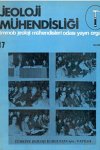
ABSTRACT Tertiary and Quaternary aged sediments and volcanic rock units cover large area« in Kula -Selendi region. Tat purpose oï the Investigation is to construct tue Oenozoio stratigraphy aneT to find outthe place of the volcanic In the stratigraphie sequence. Furthermore, because of the usefulness m regionalgsotectonic research and explanations of the petrochenucal and pétrographie Investigations in volcanlorook» we also studied Quaternary Kula basaltic volaanies in detail. The Menderes massif metamorphiosand granités constitute the basement rooks In the Investigated area (E§m© formation and Güney höyüformation). 33ıîs unit ise overlain by Mugadağı marble« Pormo-Triaaie in ago, Mesoaoic units are Kızılca,söğüt formation and Vesdrler melange emplaced In Upper Cretaceous, Wm observed Cenozolc rock unitssuck as Kürtköyü formation, Yeniköy formation, Mkondere voloànlcs, Karaboîdere vol«anlcs of Mioceneand Ahmetler formation, Ulubey Sormatîon, Beydafi volcanlca, Payamtepe volcanios of Pliocene and Asartepe formation and Kula volcaatca of Quaternary. Burgaz volcanics, Mekcitepe volcanlcs and Divlitt«pevoioanlcs were determined a» the three phase» of Kula volcanies. We evaluated fliat these rocks are indifferent origin from all the oiher voloanios in the region.
ABSTBACT: HM Idee-Knlp area Includes metanıorphlc, jgııeoııs and Miocene sedimentary rooks. Themetamorphics, m part of the southern margin of the Bitlia massif, underlying the northern part of thearea have been thrust over the Miocene sedunents In south. The Miocene sediment» have been divided In tosix distlnoi formations! Üçdaınlar tarnation, as one tof these six formations, displays, on the basis of itsmembers and their reciprocal relation», the charaeteristiea of flysch facie» and turbiditte rocks. Takingthese features in to account the Ucdamlar foımattonı has been defined a» "flysch-turbldite". The flyschturbldites are typical to toe region by their well observed graded bedding to places and various BoumaIntervals. A rose diagram prepared by the measurements from seMmeotary structures (groove and flutecasts) tatioates a turbidltio current direction from OT to NW, Fossils charecterizing both shallow anddeep marble fades conditions eo.exists in the fiyscluturaidites »* the area, This situafloo probably impliesthat some materials including Algea were first deposited to shallow water and were subjected to penecomtemporaneons »lumping and redeposition by turbidity currents to a deeper environment where Globigertaeswere settling
ABSTRACT: Boron » one of the most mobile and least abundant element», lihr average amount of boronto the Earth`s crust being estimated at less than 10 parts per million. However, it te found in mineralswhich `Dccur in nearly all geologic environments. Although boron is «>ne of tt» rarer aid mm unevenlydistributed element» in the Earth`s crust, there are extraordinary concentrations of toron deposits on anindustrial seal« in some localized areas. >r.The known borate deposits of Turkey were dejesited in lacustrine sediments of Tertiary age duringperiods of volcanic activity wh?ch commenced İn the early Tertiary period and omftnued at least to tuebeginning of the Quaternary. All Turkish borate deposit« appear to be aMoclatetİ wMth voloiuitc activity andthey have been classified as deposits related to voles nie aettvlty.Although colemanJte, a very common calcium borate, is the predominant mineral in all boratedistrict« apart friMn Ktrka, the detaUed mineralogy of the Turkish borate deposits varies considerably. Otterprincipal borate minerals are ulexlte (sodium calcium borate) and borax (sodium borate). Borax occursonly at Kfrka, TertsoMte occurs In the B^a,tUo deposits and pandermite is ateo restofcted appeaiİBg onlyin the Bigadiç and Sultancayiri deposits.Turkey has mofle recent rapid strides towards rivalling the U.S.A. a» the world*» leading producer oifborates. Boron and borate minerals find extensive uses in today`» modern induaMes,
ABSTRACT: Pliocene deposits extending along Dardanelles are oradeln by quaternary sediment whichmay be best observée! to Hamzatoy, mort of Gelibolu town. These sediment contain a rich and: very wellpreserved fauna of Tschauda (Bakımian) Oastropods which characterize the Ponto-Oaspic basin of EasternPamtethy»
ABSTRACT: Aladaf regton, iiroıınd Kii^iiksıı and IMidëken yayla, TJppeırmost Permian, Poııninıi-TriasHİc. transition, and Lowermost Triasslo are repreBented by marine Umestone sequences, la order to clarify the oharaoterlstio iof rermian-Triïissio trasiNitioıı, au Investigatton to define formnlnUera population concmwnt range zones has been carried out In thèse sequences. In the sequence where no stratigraphie hiatus could be found, the par!» corresponding to the zones exhtMt different facie». The lower part consisting of htoclastic, dark-brown limestones at Uppermost Permian age contains foraminifera i»f Dagmarlta chanakohfensta Keitlinger, dlolnvalvulina voııdersclııııitü Ileichel, Staffellai »p., FiM`hyphïoï» »p., Faradagmorlta sp,, Kamurana sp, and atgael fragments like (.Syinnoco dlum sp,t PennocalonluB sp, and Mi`/v.in, sp. This part Is defined as the first foraminifera population concurrent range zone. The seeoiMl part wlii
ABSTBACT: The study area located within the Olicia section o( antf-Tauru» portion of ïaurus belt Isframed within ttie northern portion of AJadafs,In this particular location at the bottom antlçaınMan metamorphits on it uncomfortably crystallizedCambrian Umeatonea Devonian-Oarboniferous-Permian limestones are unoomiortably situated. After thisage sorting-, the formations are named, accordingly.Thta granite tee aged as Hersinlan, In reference to structural assoeiattoni the base formations areaffected by Huronlan (Ak)î next to it by Oaledoian (Ac) and the upper unite are by Hercinhuı (AF) andby Alpen (A) orogenesis.

 TMMOB
TMMOB